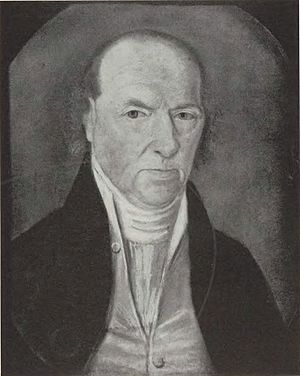John Blair Jr. facts for kids
Quick facts for kids
John Blair Jr.
|
|
|---|---|
 |
|
| Associate Justice of the Supreme Court of the United States | |
| In office February 2, 1790 – October 25, 1795 |
|
| Nominated by | George Washington |
| Preceded by | Seat established |
| Succeeded by | Samuel Chase |
| Personal details | |
| Born | April 17, 1732 Williamsburg, Virginia, British America |
| Died | August 31, 1800 (aged 68) Williamsburg, Virginia, U.S. |
| Political party | Federalist |
| Parent |
|
| Education | College of William & Mary (BA) Middle Temple |
| Signature | |
John Blair Jr. (born April 17, 1732 – died August 31, 1800) was an important American leader. He was one of the Founding Fathers and a judge. He is famous for signing the United States Constitution.
Blair was known as a very smart legal expert in his time. He preferred to work quietly behind the scenes rather than getting involved in noisy state politics. He strongly believed that the newly independent states should form a lasting union. He was a loyal supporter of his fellow Virginians, James Madison and George Washington, at the meeting where the Constitution was created. As a judge on Virginia's highest court and later on the U.S. Supreme Court, he helped shape how the Constitution was understood. People at the time admired Blair for being kind and gentle, and for his ability to quickly understand difficult legal problems.
Contents
Early Life and Education
John Blair Jr. was born in Williamsburg, in the Colony of Virginia, in 1732. His parents were Mary (Monro) and John Blair. His family was very well-known in Virginia. His father was part of the Governor's Council, which helped rule the colony. His great-uncle, James Blair, founded and was the first president of William & Mary College.
John Blair Jr. went to William & Mary College and earned his degree in 1754. In 1755, he traveled to London, England, to study law at a famous school called the Middle Temple.
Public Service and Legal Career
After finishing his law studies, Blair returned home and quickly became involved in public life. He started his career after the French and Indian War ended. He was elected to represent William & Mary College in the House of Burgesses (1766–1770), which was Virginia's law-making body. Later, he became a clerk for the Governor's Council (1770–1775).
Joining the Patriot Cause
At first, Blair was a moderate, meaning he didn't support extreme actions. He disagreed with Patrick Henry's strong protests against the Stamp Act, a tax from Britain. However, when the British Parliament closed down the House of Burgesses, Blair's views changed.
In 1770 and again in 1774, Blair joined George Washington and others to create agreements. These agreements promised that people would stop buying British goods until unfair taxes were removed. In 1775, when the British Parliament passed the Intolerable Acts (harsh laws against the colonies), Blair supported the idea of a Continental Congress. He also pledged to help the people of Boston, who were suffering because of Britain's actions.
Role in the American Revolution
When the American Revolution began, Blair became very active in Virginia's government. He was part of the group that wrote Virginia's first constitution in 1776. He held many important positions, including a seat on the committee that wrote the Virginia Declaration of Rights.
From 1776 to 1778, he advised Governor Patrick Henry as a member of the Privy Council. In 1778, the state legislature chose him to be a judge in the general court. Soon after, he became the chief justice. In 1780, he was also elected to Virginia's high court of chancery. These judicial roles automatically made Blair a member of Virginia's first court of appeals.
Important Court Decisions
On the Virginia Court of Appeals, Blair was part of a key case called The Commonwealth of Virginia v. Caton et al. (1782). This case set an important rule: courts could decide if laws made by the legislature were against the constitution. This decision was a step towards the U.S. Supreme Court's famous ruling in Marbury v. Madison many years later.
In 1786, Virginia's legislature recognized Blair's skill as a judge. They appointed him to a committee that was updating Virginia's laws, taking over from Thomas Jefferson. The next year, he was chosen as a delegate to the Constitutional Convention.
Serving on the U.S. Supreme Court
On September 24, 1789, President George Washington chose Blair to be one of the first five associate justices on the new U.S. Supreme Court. The United States Senate approved his nomination two days later.
Blair served on the Supreme Court from February 2, 1790, until October 25, 1795. During his time, the court did not have many cases, deciding only 13 over six years. However, Blair was part of the important case of Chisholm v. Georgia. This case is seen as the first major and impactful decision by the United States Supreme Court.
Personal Life and Legacy
John Blair Jr. was married to Jean Balfour Blair.
He passed away in Williamsburg on August 31, 1800. He was buried at the Bruton Parish Churchyard in Williamsburg.
Blair was also a Freemason, a member of a fraternal organization. He became the Grand Master of Freemasons in Virginia in 1778.
Blair Street in Madison, Wisconsin is named in his honor.


